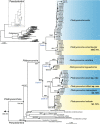Phylogeny and biogeography of Indochinese freshwater mussels in the genus Pilsbryoconcha Simpson, 1900 (Bivalvia: Unionidae) with descriptions of four new species
- PMID: 36443375
- PMCID: PMC9705414
- DOI: 10.1038/s41598-022-24844-9
Phylogeny and biogeography of Indochinese freshwater mussels in the genus Pilsbryoconcha Simpson, 1900 (Bivalvia: Unionidae) with descriptions of four new species
Abstract
The body of knowledge regarding the classification and evolution of freshwater mussels in the family Unionidae (Bivalvia) in Indochina has recently increased. However, the taxonomic revision of all extant taxa in the region is still ongoing. In this study, the genus Pilsbryoconcha was revised based on an integrative analysis of shell morphology, biogeography, and molecular data. Multi-locus phylogeny indicated the availability of eight species within the genus. Four previously recognized species are P. exilis (Lea, 1838), P. schomburgki (Martens, 1860) stat. rev., P. linguaeformis (Morelet, 1875), and P. carinifera (Conrad, 1837), while four other species are described herein as P. acuta sp. nov., P. mekongiana sp. nov., P. kittitati sp. nov., and P. hoikaab sp. nov. In addition, the neotype of P. carinifera is also designated to clarify its long taxonomic ambiguity. Divergent time estimation and historical biogeography analysis revealed that Pilsbryoconcha originated in the area now called the Khorat Plateau around the middle of the Eocene (mean age = 43.12 Mya), before its range was expanded across Indochina through a series of complex geomorphological changes of river systems, which also led to diversification of the genus.
© 2022. The Author(s).
Conflict of interest statement
The authors declare no competing interests.
Figures




Similar articles
-
Diversity, biogeography, evolutionary relationships, and conservation of Eastern Mediterranean freshwater mussels (Bivalvia: Unionidae).Mol Phylogenet Evol. 2021 Oct;163:107261. doi: 10.1016/j.ympev.2021.107261. Epub 2021 Jul 15. Mol Phylogenet Evol. 2021. PMID: 34273504
-
New freshwater mussels from two Southeast Asian genera Bineurus and Thaiconcha (Pseudodontini, Gonideinae, Unionidae).Sci Rep. 2021 May 10;11(1):8244. doi: 10.1038/s41598-021-87633-w. Sci Rep. 2021. PMID: 33972560 Free PMC article.
-
Taxonomic revision of two species in the genus Ptychorhynchus Simpson, 1900 (Bivalvia: Unionidae: Gonideinae), with description of a new species.Invertebr Syst. 2024 Jul;38:IS24014. doi: 10.1071/IS24014. Invertebr Syst. 2024. PMID: 38963889
-
Freshwater mussels (Bivalvia: Unionidae) from the rising sun (Far East Asia): phylogeny, systematics, and distribution.Mol Phylogenet Evol. 2020 May;146:106755. doi: 10.1016/j.ympev.2020.106755. Epub 2020 Feb 3. Mol Phylogenet Evol. 2020. PMID: 32028028
-
A new genus and two new species of freshwater mussels (Unionidae) from western Indochina.Sci Rep. 2019 Mar 11;9(1):4106. doi: 10.1038/s41598-019-39365-1. Sci Rep. 2019. PMID: 30858440 Free PMC article.
Cited by
-
An integrative approach to a revision of the freshwater mussel genus Songkhlanaia (Bivalvia, Unionidae), with the description of a new species.Zookeys. 2025 Jan 28;1224:187-209. doi: 10.3897/zookeys.1224.140549. eCollection 2025. Zookeys. 2025. PMID: 39911948 Free PMC article.
-
Molecular phylogeny and taxonomic position of Macrobrachiumlanchesteri (De Man, 1911), with descriptions of two new species from Thailand (Decapoda, Caridea, Palaemonidae).Zookeys. 2024 Jan 29;1190:163-193. doi: 10.3897/zookeys.1190.113898. eCollection 2024. Zookeys. 2024. PMID: 38323098 Free PMC article.
References
-
- Strayer DL. Freshwater mussel ecology: A multifactor approach to distribution and abundance. Berkeley: University of California Press; 2008.
-
- Graf DL, Cummings KS. A ‘big data’ approach to global freshwater mussel diversity (Bivalvia: Unionoida), with an updated checklist of genera and species. J. Molluscan Stud. 2021;87:034. doi: 10.1093/mollus/eyaa034. - DOI
-
- Pfeiffer JM, Graf DL, Cummings KS, Page LM. Taxonomic revision of a radiation of Southeast Asian freshwater mussels (Unionidae: Gonideinae: Contradentini+Rectidentini) Invertebr. Syst. 2021;35:394–470. doi: 10.1071/IS20044. - DOI
-
- Jeratthitikul E, Sutcharit C, Ngor PB, Prasankok P. Molecular phylogeny reveals a new genus of freshwater mussels from the Mekong River Basin (Bivalvia: Unionidae) Eur. J. Taxon. 2021;775:119–142. doi: 10.5852/ejt.2021.775.1553. - DOI
Publication types
MeSH terms
LinkOut - more resources
Full Text Sources

